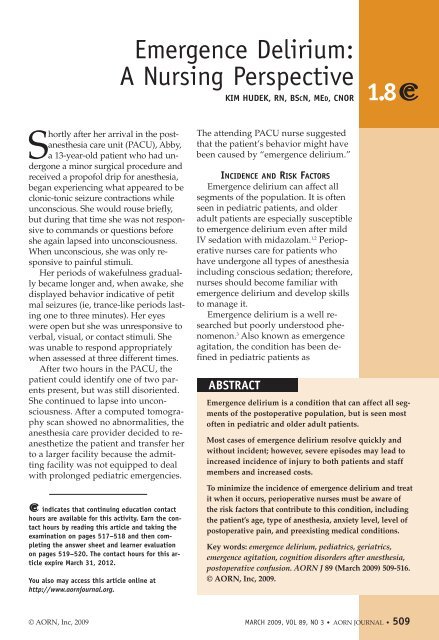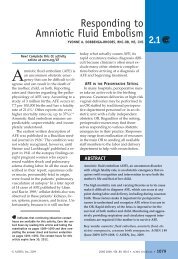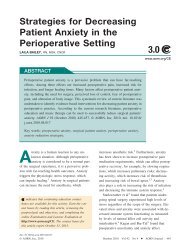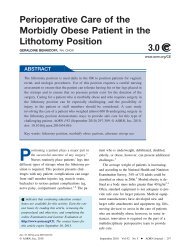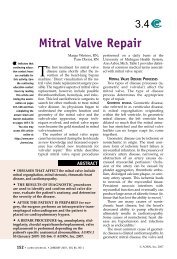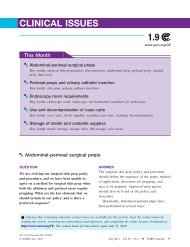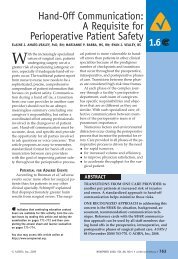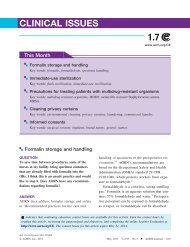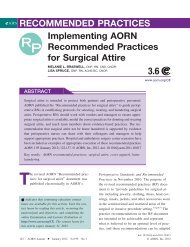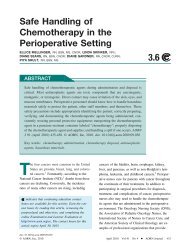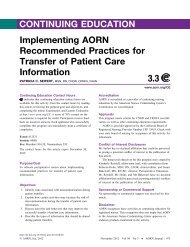Emergence Delirium: A Nursing Perspective - AORN
Emergence Delirium: A Nursing Perspective - AORN
Emergence Delirium: A Nursing Perspective - AORN
Create successful ePaper yourself
Turn your PDF publications into a flip-book with our unique Google optimized e-Paper software.
MARCH 2009, VOL 89, NO 3HudekIn older adult patients, conditionssuch as depression, drug dependency,or organic brain disease increase thelikelihood of emergence delirium.a dissociated state of consciousness in whichthe child is inconsolable, irritable, uncompromisingor uncooperative, typically thrashing,crying, moaning and incoherent. 3While much of the research has focused on pediatricpatients, people of all ages may exhibitsymptoms of emergence delirium. <strong>Emergence</strong>delirium occurs in approximately 5.3% of allpostoperative patients; however, when the statisticsfocus on pediatric patients, the incidenceincreases to between 12% and 13%. 3 The incidenceof emergence delirium rises to between10% and 15% when only the geriatric populationis examined. 1,2<strong>Emergence</strong> delirium is noted in the immediatepostoperative period, usually occurring duringthe first 15 to 30 minutes after surgery. 3,4 Ingeriatric patients, delirium may be prolongedand may not be diagnosed until eight to 24hours postoperatively. 4 It takes longer for emergencedelirium symptoms to occur, possibly becauseolder adults metabolize anesthesia medicationsat a slower rate. Although most patientsexperiencing emergence delirium displayperiods of excitement alternating with periodsof lethargy, older adult patients may presentwith restlessness and behavioral regression (eg,the patient may be verbally abusive or displayinfantile behavior) without notable changes inphysical behavior. 1,4Many studies have examined the causes ofemergence delirium. Most inhalation agents andIV agents including midazolam, remifentanil,and propofol have been associated with thiscondition. 1,3,4 Other medications associated withan increased incidence of emergence deliriuminclude atropine, ketamine, droperidol, and possiblybarbiturates. 1,3 Factors correlated to the occurrenceof emergence delirium include• a rapid emergence from anesthesia withoutadequate pain control,• younger or advanced age,• no previous surgery,• poor adaptability,• large blood loss during surgery, 4• postoperative pain, 1,2,4• use of sevoflurane or isoflurane or a combinationof both, and• use of analgesics. 3,4In older adult patients, psychiatric conditionssuch as depression, drug dependency, or organicbrain disease increase the likelihood of emergencedelirium. 1,2 Patients undergoing ophthalmological,otorhinolaryngological, breast, or abdominalsurgeries also appear to run a higherrisk of emergence delirium. 1-3The factor that appears throughout the literatureas the most prevalent link to emergencedelirium is preoperative anxiety. 1-6 In the types ofsurgeries noted above, specific anxiety over disfigurement,suffocation, pain, and the generaloutcome of surgery add to the general anxietyabout having surgery that most patients experience.1,2 Children who experience acute separationanxiety or anxiety as a reaction to parental anxietyare at a greater risk for emergence delirium. 6NURSING CARE OF PATIENTSEXPERIENCING EMERGENCE DELIRIUMWhen a patient begins to display symptomsof what may be emergence delirium, it is importantthat the nurse search for an underlyingcause of this behavior. Urinary retention, hypoxia,severe hypercarbia, hypotension, hypoglyce -mia, increased intracranial pressure, electrolyteimbalance, sepsis, embolism, alcohol withdrawal,sensory deprivation, sensory overload, andpain are conditions that may lead the patientto exhibit a variety of emergence delirium-likebehaviors. 1,3,4 Behavior seen under these circumstancesmay not be emergence delirium. Painmay be a difficult factor to identify, especially inchildren, so the use of a pain scale may be helpful.4 The patient’s cognitive status and level ofconsciousness must be evaluated when assessingfor emergence delirium. 4510 • <strong>AORN</strong> JOURNAL
Hudek MARCH 2009, VOL 89, NO 3ASSESSMENT OF AGITATION. The use of an agitationscale may help to define the level of a patient’sagitation. Use of the Riker sedation-agitationscale and the Richmond sedation-agitationscale are recommended because they have excellentinterrater reliability and are easy to use,especially in emergency situations. 2,7-9 Bothscales allow clinicians to rate the quality of apatient’s level of consciousness and behavior.For emergence delirium, the Riker scale providesa spectrum of measurement that coverspatients who are “unarousable” to patientswho are “dangerously agitated.”TREATMENT. Treatment of emergence deliriumbegins with the basics—maintaining the patient’sairway, breathing, and circulation. Airwaymaintenance is always the priority in anysituation. If the patient is experiencing difficultymaintaining an open airway, the use of anoral airway or performing a jaw thrust or chinlift maneuver may aid in opening the airway.These actions, however, may make a patientexperiencing emergence delirium more combativeso the use of a chemical restraint (ie, sedatingmedications) may be necessary until theairway is well established. The anesthesia careprovider may prescribe treatment to relax theairway to reduce laryngospasms.An adhesive pulse oximeter reduces the bulkof a clip-on type and stays on the patient better ifhe or she is thrashing about. Although the fingeris often the digit of choice for application, the patientmay be less aware of it if it is attached to atoe, and this may reduce the patient’s agitation.The nurse can assist the patient’s breathingby placing the patient in a semi-Fowler position,providing supplemental oxygen, andmaking sure no weight is on his or her chest(eg, a casted arm). If the patient’s oxygen maskbecomes an irritant, the nurse can place it justoff the patient’s face where he or she may stillreceive some benefit from the oxygen. Somepatients find the nasal cannula in their naresannoying but demonstrate a higher tolerancefor the cannula resting on their lips.It is important to monitor blood pressure inany postoperative patient. The pressure of theblood pressure cuff, however, may feel invasiveto some patients and may trigger anepisode of agitated behavior. It may help toTreatment of emergence deliriumbegins with the basics—maintainingthe patient’s airway, breathing,and circulation.lessen the effects of the cuff’s presence by settingthe timed inflation intervals as far apart aspossible and preparing the patient by informinghim or her of the squeeze pressure just beforeinflation.If the patient’s blood pressure is lower thannormal postoperatively, the nurse can reviewthe effects of the medications given, and checkthe patient’s positioning and blood or fluidloss. Increasing the volume of the IV fluids infusing,if not detrimental to the patient’s condition,may assist in raising the patient’s bloodpressure. Most cases of emergence deliriumwill resolve spontaneously with no interventionother than supportive care. 2-4 While thereare many variables that contribute to emergencedelirium, presence of an endotracheal(ET) tube, pain, and anxiety appear to be themost prevalent. 2 Removal of the ET tube, treatmentof pain, and reassurance may assist thepatient in emerging from his or her confusion.There is much debate in the literature aboutthe use of pharmaceuticals in the treatment ofemergence delirium. 1,2,4 Opioids; propofol;flumazenil; benzodiazepines (eg, midazolam);and antipsychotics may be chosen to either reverseor relieve unwanted behaviors (ie, bychemical restraint) or treat underlying causesof emergence delirium. 3,4Much of the debate in the literature aboutthe use of pharmaceuticals to treat emergencedelirium concentrates on the use of midazolamas an anxiety reliever preoperatively. Onestudy found that preoperative use of midazolamversus a placebo reduced the incidence ofemergence delirium; however, the authorswere not sure whether this effect was caused<strong>AORN</strong> JOURNAL • 511
MARCH 2009, VOL 89, NO 3HudekDocumenting the presence ofemergence delirium is important,and nursing care provided to manageit should be included in thepatient’s plan of care.by the medication or the fact that children premedicatedwith midazolam had a slower awakeningfrom anesthesia. 3 In another study, researchersfound that premedication with midazolamdid reduce the incidence of negativebehaviors postoperatively but did not necessarilyreduce the incidence of emergence delirium. 6Wells et al concluded from their observationsthat premedication with an anti-anxiety medicationdoes not prevent emergence delirium. 5 Allthese authors agree that there is a complex networkof factors that intermingle in trying to decipherthe cause of emergence delirium; therefore,trying to prevent emergence delirium isjust as multifaceted. 3,5,6It is important to provide a calm and reassuringenvironment with constant reality orientationfor patients experiencing emergencedelirium. Patients displaying paranoid ideationwill need continual guidance. 3-5 Patients whoslip into unconsciousness need to be reorientedeach time they regain consciousness. Controllingthe environment and providing adequateand proper stimulation for the patient isimportant. This may include having familymembers remain with the patient throughouthis or her PACU stay. 4Adequate and proper stimulation for the patientis individualized based on the patient’smaturational level and coping mechanisms. Fora child, having the parents present and playingsoothing music may be appropriate. 3 If the parentsare highly anxious or distraught at seeingtheir child in an agitated state, however, thechild may respond better without the parentspresent. In one incident of emergence delirium,an adult patient was convinced that his wifewas in grave danger. The nurse brought his wifeinto the PACU to assure him that she was allright. His wife stayed in the unit to reassure himthroughout his recovery. 1 Other patients may becomforted by a quiet environment with littledisturbance and calm, quiet care from staffmembers.DOCUMENTATION AND PATIENT TEACHING. Documentingthe presence of emergence delirium is important,and nursing care provided to manageit should be included in the patient’s plan ofcare (Table 1). The presence of emergence deliriumand how to care for the patient after dischargeshould be explained to family membersand caregivers. Family members or caregiversalso should be made aware that in older adultpatients, the presence of emergence deliriummay be a harbinger of postoperative delirium,which can appear hours, days, or weeks aftersurgery. 4 <strong>Emergence</strong> delirium also may be associatedwith maladaptive behavior in childrenmonths after surgery. 6 This behavior may be expressedas generalized anxiety, nighttime crying,enuresis, temper tantrums, and separationanxiety. Postoperative teaching is important tohelp caregivers be alert for the onset of postoperativedelirium and maladaptive behaviorsand provide support to the patient.DECREASING THE RISK OF EMERGENCE DELIRIUMThere is no identified way of preventingemergence delirium, but there are steps nursescan take that may decrease its incidence. Identifyingrisk factors for emergence delirium canaid in identifying patients who might experienceit and allow staff members and the patient’sfamily members or caregivers to manageit if it occurs. 2,4 Risk factors include• the patient’s age,• type of surgery,• type of anesthesia,• previous response to surgery,• pre-existing medical conditions, and• current medications.PREOPERATIVE ASSESSMENT. Administering a structuredpreoperative evaluation of the risk factorsfor emergence delirium, as well as the patient’sanxiety, can alert perioperative team members to512 • <strong>AORN</strong> JOURNAL
Hudek MARCH 2009, VOL 89, NO 3the possibility that emergence delirium mayoccur. 2 If the patient’s anxiety is high, the nursecan implement steps to reduce it. The nurseshould encourage any person unfamiliar withthe hospital environment, especially a child andhis or her family members, to visit the hospitalbefore surgery or ensure that admission personneltake additional time when the patient arrives,allowing him or her to become accustomedto the hospital environment. All clinicalinterventions taken to prepare the patient forsurgery should be explained in as much detailas the patient requires, and the nurse shouldallow the patient adequate time to ask questions.In the case of pediatric patients, the nurseshould take time to orient and reassure the parentsas well as the child. Parental anxiety mayrelate directly to a child’s anxiety level. 6 Studieshave shown that anxiety levels are lower in peoplewho have been able to familiarize themselveswith the hospital setting and any plannedprocedures. 4,6Preoperative patient teaching is an importantstep for reducing patient anxiety. Knowledgeof what will occur and what to expectafter surgery—especially in regard to catheters,surgical drains, and IVs—may lessen a patient’spostoperative distress. 2 Individual attentionto each patient is important. The nurseneeds to balance both the amount of detail andhow information is presented to each patientso that anxiety is lessened and not increased.Preoperative sedation to lessen anxiety isdiscussed in the literature as having varyingresults. Some studies demonstrate that premedicationwith midazolam or clonidine reducesthe incidence of emergence delirium,while other studies show the opposite effect. 2-4,6Patients taking antidepressants have a lowerincidence of emergence delirium than the generalpopulation, probably because of the medications’anxiety-reducing effects; however, administeringthese medications is not recommendedto prevent emergence delirium. 2,4INTRAOPERATIVE CARE. Attempts to reduce patientanxiety should continue into the intraoperativesetting. Perioperative staff membersshould work to provide a calm, reassuring environmentin the OR. Distracting noise or conversationsunrelated to patient care should beeliminated as much as possible, both duringinduction and emergence from anesthesia.During induction, the patient should be allowedto hold his or her anesthetic mask if desired.Children should be allowed to take transitionalobjects such as a favorite blanket orsmall toy with them to the OR, and a parent orcaregiver should accompany the child to the ORfor induction whenever possible.Fentanyl administered intraoperativelymay assist in reducing emergence delirium inchildren. 3 The type of inhalation anestheticsgiven to children 3 and the use of inhalationanesthetics versus propofol in adults 2 may increasethe incidence of emergence delirium. Inolder adults, a large blood loss during surgeryis associated with emergence delirium. 4 Theseissues should be communicated to the PACUreceiving nurse.POSTOPERATIVE CARE. Postoperatively, pain is amajor precipitating factor for emergence deliriumso it is important that the patient receive adequatepain control. 1,2,4 The nurse should be alertfor nonverbal signs of pain (eg, restlessness; facialgrimacing; holding or trying to support thearea causing pain; elevated blood pressure;rapid, weak, or bounding pulse; elevated respirations)and use a pain scale when applicable. 4Other factors that may influence emergencedelirium, such as bladder distension and hypoglycemia,will require initiative on the part ofthe nurse to assess and treat.Supplemental oxygen is important, but theirritation of a nasal cannula or the perceived“confinement” of an oxygen mask may exacerbatesymptoms of emergence delirium. 2 If thepatient appears bothered by the nasal cannula,the nurse can consider switching to a mask, orif the patient is bothered by the mask, the nursecan let the mask sit loosely just off of the patient’sface if his or her oxygen saturation remainsadequate.Reality orientation as the patient is comingout of anesthesia in a calm environment willprovide a smooth transition to wakefulness forthe majority of patients. Knowing that theirprimary care provider is with them in thePACU may lower children’s levels of anxietyand allow them to adjust more smoothly asthey emerge from anesthesia.<strong>AORN</strong> JOURNAL • 513
MARCH 2009, VOL 89, NO 3HudekTABLE 1<strong>Nursing</strong> Care Plan for Patients at Risk for <strong>Emergence</strong> <strong>Delirium</strong>[applicable PNDS code]DiagnosisRisk for anxiety[X4] related to deficientknowledge,stress ofsurgery [X30],and disturbedbody image [X6]<strong>Nursing</strong> intervention• Assesses psychosocial status [I68]; barriersto communication (eg, sensory impairment)[I134]; and knowledge level [I135].• Assesses readiness to learn [I136] and copingmechanisms (eg, body image issues) [I137]and elicits perceptions of surgery [I32].• Explains sequence of events and reinforcesteaching about treatment options [I56].• Implements measures to provide psychologicalsupport [I147].• Provides instructions based on age andidentified needs [I106], including familymembers when appropriate in preoperativeteaching [I79] and discharge planning [I80].• Evaluates psychosocial response to plan ofcare [I147], phases of wound care [I49], andinstruction [I50].• Provides preoperative [I79] and dischargeteaching [I80], including family memberswhenever possible.OutcomemeasurementThe patient verbalizesunderstandingof the procedureand expected outcomes,demonstratesknowledge of emotionalresponses tosurgery and the diseaseprocess, anddemonstrates decreasedanxiety andan ability to copethroughout the perioperativeperiod.OutcomestatementThe patientdemonstratesknowledge ofexpected responsesto thesurgical procedure[O31].Risk for acutepain [X38]• Assesses pain control [I16] and tolerablelevel of pain using an analog pain scale.• Identifies cultural and value componentsrelated to pain [I61].• Provides care in a non-discriminatory, nonprejudicialmanner regardless of the settingin which care is given [I79].• Implements pain management guidelines[I71], emphasizing how family members canassist with pain management interventions.• Administers prescribed medications andsolutions [I8].• Implements alternative methods of paincontrol (eg, diversified activities, therapeutictouch, meditation, breathing, positioning)to augment traditional pain controlmethods [I69].• Collaborates in initiating patient-controlledanalgesia, if appropriate [I24].• Evaluates response to pain managementinterventions [I54].The patient’s postoperativevital signsand other nonverbalsymptoms remainstable, indicating adequatepain control.The patient demonstratesand reportsadequate pain controlthroughout theperioperative period.Based on arecognized painscale, the patient’sfacial expressionsare relaxed, he orshe rests comfortablyand deniesdiscomfort.The patientdem onstratesand/or reportsadequatepain controlthroughout theperioperativeperiod [O29].The patientdemonstratesknowledge ofpain management[O20].The patient ‘sneurologicalstatus is consistentwith orimproved frombaseline [O30].EFFECTS OF EMERGENCE DELIRIUM<strong>Emergence</strong> delirium is costly in terms ofmorbidity, human resources, and finances. 2During their state of confusion or delirium, patientshave been known to extubate themselvesor pull out surgical drains, IVs, and indwellingcatheters. During their confusion, patientsmay cause greater pain for themselves ordamage to their surgical site. 2-4 In some cases,this may delay healing, prolong physiotherapy,or require further surgery to repair thedamage caused. Postoperatively, patients may514 • <strong>AORN</strong> JOURNAL
Hudek MARCH 2009, VOL 89, NO 3DiagnosisTABLE 1 (CONTINUED)<strong>Nursing</strong> Care Plan for Patients at Risk for <strong>Emergence</strong> <strong>Delirium</strong>[applicable PNDS code]<strong>Nursing</strong> intervention• Provides pain management instructions[I108].• Evaluates response to pain managementinstructions [I53].OutcomemeasurementThe patient’s cognitionand affectiveresponse is appropriate.The patient is cooperativeand verb -alizes ability to cope.OutcomestatementRisk for injury[X29]• Identifies risks for emergence delirium byassessing pain control [I16]; evaluatespsychosocial response to plan of care[I47], response to instructions [I50], responseto medications [I51], and responseto pain management measures [I54]; andidentifies psychological status [I66].• Verifies the patient’s identity, allergies,NPO status, informed consent, and laterality[I26, I123, I124, I143].• Identifies physiological status [I66] (eg,skin integrity, sensory impairments [I90],musculoskeletal status).• Applies safety devices [I11] and maintainscontinuous surveillance [I128].• Evaluates for signs and symptoms ofphysical injury [I152].The patient’s skinremains intact, non -reddened, and freeof blistering; motionsensation and circulationare maintainedor improvedduring the perioperativeperiod.The patient experiencesno adverse effectsof deliriumduring emergencefrom anesthesia.The patient isfree of signs andsymptoms ofphysical injuryduring the perioperativeperiod[O1].Risk for acute confusion[X11], fear[X16], disturbedthought processes[X59], impairedverbal communication[X64], and ineffectivecoping [X68]due to emergencedelirium• Identifies psychological status [I66].• Notes sensory impairments [I90].• Identifies barriers to communication[I134].• Evaluates response to instructions [I50].• Implements measures to provide psychologicalsupport [I147].• Assesses baseline neurological status[I144] and assesses postoperative neurologicalstatus [I146].• Implements measures to protect the patientfrom injury [I138].The patient describesthe sequence ofevents, repeats instructionscorrectly,asks questionsbased on informationprovided, andparticipates in care.The patient is calm,cooperates with theplan of care, has arelaxed facial expression,and verbalizesthe abilityto cope.The patient demonstratesknowledgeof the expected responsesto the operativeor invasiveprocedure [O31].The patient participatesin decisionsregarding his orher care [O23].The patient’s careis consistent withthe individualizedperioperative planof care [O24].experience sore throats from premature extubation,urinary strictures from inadvertent removalof catheters, and infections from injury tothe surgical site or drain removal. Complicationsmay extend well into the period after the patientis discharged from the hospital.Additional human resources are requiredwhen a patient experiences emergence deliriumbecause it may take up to six people to restrainan agitated patient. As in any situation where restraintof an uncooperative patient is needed,there is also a risk of injury to the hospital staff<strong>AORN</strong> JOURNAL • 515
MARCH 2009, VOL 89, NO 3Hudekmembers. 2,4 <strong>Emergence</strong> delirium can increase patientcosts because of the increased length oftime spent in the PACU, extra pharmaceuticalsused to try to resolve the emergence delirium orto protect the patient, repair of any physicaldamage the patient may cause to himself or herself,and the cost for an increased number ofstaff members to care for the patient. 2,4 It is importantthat nurses, physicians, and anesthesiacare providers work together to recognize patientsat risk for emergence delirium, reduce itsoccurrence whenever possible, and successfullytreat it when it occurs.CONCLUSIONThe final diagnosis for Abby was an “adversereaction to anesthesia.” She returned tothe admitting hospital for follow up twoweeks after her transfer. She was in good spiritsand was having no notable ill effects fromher experience. She had no recollection ofwhat had happened in the PACU. Abby recalledjoking with the anesthesia care providerin the preoperative holding area and thenwaking up in the facility to which she wastransferred. For the patient, it did not appearto be a traumatic experience; however, it is animportant part of her medical history thatshould be taken into consideration in any futuresurgical experiences.REFERENCES1. Burns SM. <strong>Delirium</strong> during emergence fromanesthesia: a case study. CritCare Nurse. 2003;23(1):66-69.2. Lepousé C, Lautner CA, Liu L, Gomis P, Leon A.<strong>Emergence</strong> delirium in adults in the post-anesthesiacare unit. Br J Anaesth. 2006;96(6):747-753.3. Mason LJ. Pitfalls of pediatric anesthesia. Societyfor Pediatric Anesthesia. http://www.pedsanesthesia.org/meetings/2004winter/pdfs/mason_Pitfalls.pdf.Accessed January 28, 2009.4. Neugeborn I. <strong>Emergence</strong> delirium. DownstateAnesthesia. http://downstateanesthesia.org/Education/Optimized%20Files/<strong>Emergence</strong>%20<strong>Delirium</strong>.ppt. Accessed January 10, 2009.5. Wells LT, Rasch DK. <strong>Emergence</strong> “delirium” aftersevoflurane anesthesia: a paranoid delusion? AnesthAnalg. 1999;88(6):1308-1310.6. Kain Z, Caldwell-Andrews A, Maranets I, et al.Preoperative anxiety and emergence delirium andpostoperative maladaptive behaviors. Anesth Analg.2004;99(6):1648-1654.7. Riker RR, Fraser GL, Simmons LE, Wilkins ML.Validating the sedation-agitation scale with theBispectral Index and Visual Analog Scale in adultICU patients after cardiac surgery. Intensive CareMed. 2001;27(5):853-858.8. Riker RR, Fraser GL. Monitoring sedation, agitation,analgesia, neuromuscular blockade, and deliriumin adult ICU patients. Semin Respir Crit Care Med.2001;22(2):189-198.9. Sessler CN, Gosnell MS, Grap MJ, et al. TheRichmond Agitation-Sedation Scale: validity andreliability in adult intensive care unit patients. AmJ Respir Crit Care Med. 2002;166(10):1338-1344.Kim Hudek, RN, BScN, MEd, CNOR, is aperioperative nurse at Western Arizona RegionalMedical Center, Bullhead City, AZ.Ms Hudek has no declared affiliation that couldbe perceived as a potential conflict of interest inpublishing this article.516 • <strong>AORN</strong> JOURNAL
Examination 1.8<strong>Emergence</strong> <strong>Delirium</strong>: A <strong>Nursing</strong> <strong>Perspective</strong>PURPOSE/GOALTo educate perioperative nurses about caring for patients at risk for or experiencing emergencedelirium.BEHAVIORAL OBJECTIVESAfter reading and studying the article on emergence delirium, nurses will be able to1. describe the symptoms of emergence delirium,2. discuss perioperative patient populations in which emergence delirium is most likely to occur,3. identify risk factors that are thought to predispose patients to emergence delirium, and4. discuss ways perioperative nurses can reduce the incidence of emergence delirium.QUESTIONS1. <strong>Emergence</strong> delirium in children has beendescribed as a dissociated state of consciousnessin which the child is inconsolableor uncooperative.a. trueb. false2. The patient populations most likely to experienceemergence delirium are1. older adults.2. middle aged women.3. children.4. men between the ages of 20 and 25.a. 1 and 3b. 2 and 4c. 2, 3, and 4d. 1, 2, 3, and 43. <strong>Emergence</strong> delirium is most often notedin the immediate postoperative periodand usually occurs during the first ____minutes after surgery.a. 5 to 10b. 10 to 15c. 15 to 30d. 30 to 454. Most patients with emergence deliriumpresent with periods of excitement thatalternate with periods of lethargy.© <strong>AORN</strong>, Inc, 2009a. trueb. false5. The following agents have been associatedwith emergence delirium:1. most inhalation agents2. most IV agents including midazolam,remifentanyl, and propofol3. atropine and ketamine4. droperidol5. barbituratesa. 1 and 2b. 1, 2, and 4c. 3, 4, and 5d. 1, 2, 3, 4, and 56. The following conditions increase thelikelihood of emergence delirium occurringin an older adult patient:1. depression2. drug dependency3. stroke4. organic brain disease5. allergiesa. 1 and 3b. 1, 2, and 4c. 1, 3, and 5d. 1, 2, 3, 4, and 57. In the literature, the factor that appears toMARCH 2009, VOL 89, NO 3 • <strong>AORN</strong> JOURNAL • 517
MARCH 2009, VOL 89, NO 3Examinationbe most often linked to emergence deliriumisa. the amount of blood loss.b. the patient’s age.c. preoperative anxiety.d. the type of surgery.8. To reduce the risk of emergence delirium,the perioperative nurse can1. administer a structured preoperativeassessment that screens for risk factors.2. provide preoperative sedation.3. provide individualized preoperativeteaching to the patient about the surgicalexperience.4. implement steps to reduce patientanxiety.5. assist the patient in becoming familiarwith the hospital environment.a. 1 and 2b. 1, 3, and 4c. 1, 3, 4, and 5d. 1, 2, 3, 4, and 59. It is important to reduce distracting noiseand conversations unrelated to patient careduring induction of and emergence fromanesthesia.a. trueb. false10. Because postoperative pain is a major precipitatingfactor for emergence delirium,the nurse should be alert for _____ ______and use a ________________ to assess thepatient.a. restlessness/mental status examb. nonverbal signs of pain/pain scalec. agitation/Riker agitation-sedation scaled. moaning/level of consciousness examThe behavioral objectives and exam -ination for this program were preparedby Helen Starbuck Pashley, RN, MA,CNOR, clinical editor, with consultationfrom Susan Bakewell, RN, MS, BC,director, Center for Perioperative Education.Ms Pashley and Ms Bakewell haveno declared affiliations that could be perceivedas potential conflicts of interest inpublishing this article.This program meets criteria for CNOR and CRNFA recertification, as wellas other continuing education requirements.<strong>AORN</strong> is accred ited as a provider of continuing nursing education by theAmerican Nurses Creden tialing Center’s Commission on Accredit ation.<strong>AORN</strong> recognizes this activity as continuing education for registerednurses. This recognition does not imply that <strong>AORN</strong> or the AmericanNurses Credentialing Center approves or endorses products mentionedin the activity.<strong>AORN</strong> is provider-approved by the California Board of Registered <strong>Nursing</strong>,Provider Number CEP 13019. Check with your state board of nursingfor acceptance of this activity for relicensure.518 • <strong>AORN</strong> JOURNAL
Answer Sheet<strong>Emergence</strong> <strong>Delirium</strong>:A <strong>Nursing</strong> <strong>Perspective</strong>1.8Event #09101Session #1114Please fill out the application and answer formon this page and the evaluation form on the backof this page. Tear the page out of the Journal or makephotocopies and mail with appropriate fee to:<strong>AORN</strong> Customer Servicec/o <strong>AORN</strong> Journal Continuing Education2170 S Parker Rd, Suite 300Denver, CO 80231-5711or fax with credit card information to(303) 750-3212.Additionally, please verify by signature that youhave reviewed the objectives and read thearticle, or you will not receive credit.Signature ______________________________________1. Record your <strong>AORN</strong> member identification number inthe appropriate section below. (See your membercard.)2. Completely darken the spaces that indicate your answersto examination questions 1 through 10. Use blueor black ink only.3. Our accrediting body requires that we verify the timeyou needed to complete this 1.8 continuing educationcontact hour (108-minute) program. ______4. Enclose fee if information is mailed.<strong>AORN</strong> (ID) #_________________________________________Name_______________________________________________Address _____________________________________________City ___________________________________________________Phone number _______________________________________RN license #____________________________________________Fee enclosed ___________________________________________State __________ Zip __________State __________or bill the credit card indicated ■ MC ■ Visa ■ American Express ■ DiscoverCard # __________________________________ Expiration date _____________________Signature _______________________________________________________________ (for credit card authorization)Fee: Members $9Nonmembers $18Program offered March 2009The deadline for this program is March 31, 2012© <strong>AORN</strong>, Inc, 2009A score of 70% correct on the examination is required for credit.Participants receive feedback on incorrect answers.Each applicant who successfully completes this programwill receive a certificate of completion.MARCH 2009, VOL 89, NO 3 • <strong>AORN</strong> JOURNAL • 519
1.8Learner Evaluation<strong>Emergence</strong> <strong>Delirium</strong>: A <strong>Nursing</strong> <strong>Perspective</strong>This evaluation is used to determine theextent to which this continuing educationprogram met your learning needs. Rate theseitems on a scale of 1 to 5.PURPOSE/GOALTo educate perioperative nurses about caring forpatients at risk for or experiencing emergencedelirium.OBJECTIVESTo what extent were the following objectives ofthis continuing education program achieved?1. Describe the symptoms of emergencedelirium.2. Discuss perioperative patient populationsin which emergence delirium is most likelyto occur.3. Identify risk factors that are thought to predisposepatients to emergence delirium.4. Discuss ways perioperative nurses can reducethe incidence of emergence delirium.CONTENTTo what extent5. did this article increase your know ledgeof the subject matter?6. was the content clear and organized?7. did this article facilitate learning?8. were your individual objectives met?9. did the objectives relate to the overallpurpose/goal?TEST QUESTIONS/ANSWERSTo what extent10. were they reflective of the content?11. were they easy to understand?12. did they address important points?LEARNER INPUT13. Will you be able to use the informationfrom this article in your work setting?1. yes2. no14. I learned of this article via1. the <strong>AORN</strong> Journal I receive as an <strong>AORN</strong>member.2. an <strong>AORN</strong> Journal I obtained elsewhere.3. the <strong>AORN</strong> Journal web site.15. What factor most affects whether you takean <strong>AORN</strong> Journal continuing educationexamination?1. need for continuing education contacthours2. price3. subject matter relevant to currentposition4. number of continuing education contacthours offeredWhat other topics would you like to see addressedin a future continuing education article?Would you be interested or do you knowsomeone who would be interested in writingan article on this topic?Topic(s): ____________________________________________________________________________Author names and addresses: ___________________________________________________________________________________________________520 • <strong>AORN</strong> JOURNAL • MARCH 2009, VOL 89, NO 3 © <strong>AORN</strong>, Inc, 2009


